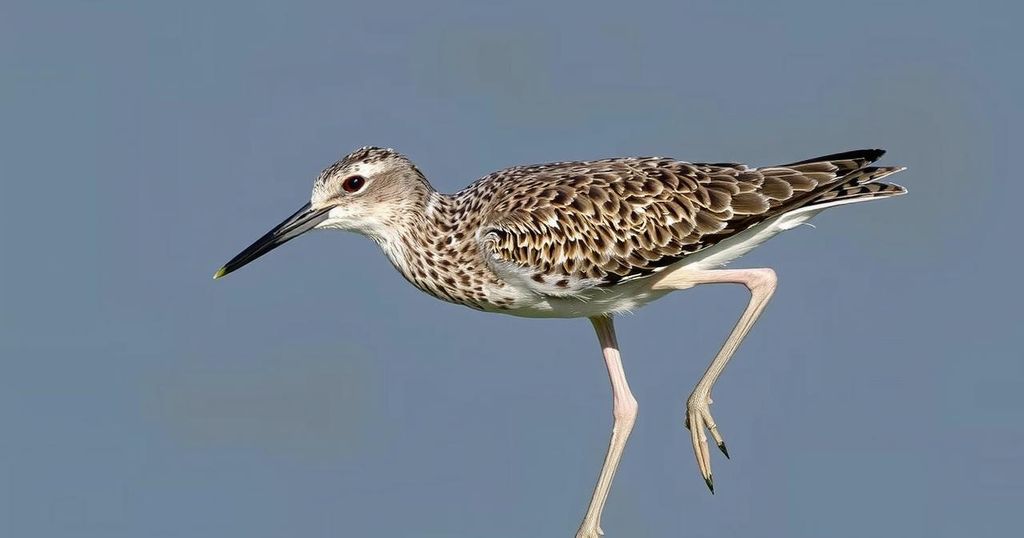Confirmation of the Extinction of the Slender-Billed Curlew: A Call for Urgent Conservation Action

The Slender-billed Curlew has been declared extinct, marking the first known bird extinction from mainland Europe, North Africa, and West Asia. Last seen in 1995, its decline resulted from habitat loss, hunting, and potential impacts from climate change. This extinction underscores the urgent need for global conservation efforts as part of the ongoing crisis threatening bird populations worldwide.
A recent publication has confirmed the extinction of the Slender-billed Curlew, a migratory shorebird that once inhabited western Siberia during the breeding season and the Mediterranean region during winter. The species was last observed in northern Morocco in 1995. This marks the first documented global extinction of a bird from mainland Europe, North Africa, and West Asia, highlighting significant conservation failures. The research, conducted by a collaboration between the RSPB, BirdLife International, Naturalis Biodiversity Center, and the Natural History Museum, underscores the urgent need for concerted efforts in bird conservation. The decline of the Slender-billed Curlew may stem from various factors, including habitat loss due to agricultural drainage of breeding grounds, the destruction of coastal wetlands necessary for winter feeding, and hunting pressures on already dwindling populations. Although other potential influences such as pollution, disease, and climate change may have played roles, their specific effects remain largely unquantified. The urgency of addressing these issues cannot be overstated, as climate change continues to threaten avian populations globally. Dr. Alex Bond from the Natural History Museum highlighted the extensive efforts made to locate the Slender-billed Curlew after its absence from its wintering ground, stating, “Several expeditions, hundreds of thousands of square kilometres searched. And all this has turned up, unfortunately, is nothing.” Subsequently, he emphasized the ongoing threats, indicating that “as climate change continues, this is going to be the status quo.” The news of this extinction coincides with the uplisting of 16 additional migratory shorebird species to higher threat categories on the IUCN Red List, further reflecting the alarming trends in bird populations. Alex Berryman, Red List Officer at BirdLife International, remarked on the broader implications, stating that “the devastating loss of the Slender-billed Curlew sends a warning that no birds are immune from the threat of extinction.” The extinction of the Slender-billed Curlew serves as a stark reminder of the interconnectedness of migratory bird species and the urgent need for international collaboration in conservation efforts. Nicola Crockford from the RSPB articulated the systemic failures, expressing concern over the rhetorical question, “How can we expect countries beyond Europe to step up for their species when our comparatively wealthy countries have failed?” This extinction not only emphasizes the dire state of avian populations but also calls for immediate and enhanced global actions to protect biodiversity.
The Slender-billed Curlew, known for its migratory patterns between western Siberia and the Mediterranean, is an exemplar of the substantial environmental changes impacting bird populations. With several documented threats such as habitat loss, hunting, and climate-related impacts, the species epitomizes the consequences of inadequate conservation measures within a global context. The confirmation of its extinction highlights the pressing need for robust conservation strategies aimed at both migratory and resident birds, particularly in regions facing significant ecological challenges.
The extinction of the Slender-billed Curlew stands as a grave warning about the threats facing bird species globally, particularly in the context of habitat destruction and climate change. This event is not only the loss of a species but a reflection of broader conservation failures that demand immediate international response and unified conservation efforts. The plight of migratory birds emphasizes the necessity of collaborative action across borders to safeguard the remnants of our biodiversity for future generations.
Original Source: www.birdlife.org






